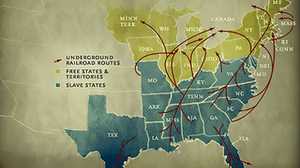On the Eve of War
The North
In the North, great mill towns had begun to rise. Work that had been done on a small scale by craftspeople in homes or small shops was now being done in huge mills, driven by water power and even by steam engines.
Manchester, New Hampshire
Amoskeag Falls, an 85-foot drop in the Merrimack River, provided the power for a number of Manchester mills, including the Amoskeag Manufacturing Company, one of the biggest textile manufacturers in the world. Cotton grown in the South was transformed into cloth here and in other mills across New England. Finished products were shipped from Manchester to Boston by the Merrimack River and the Middlesex Canal.
Lynn, Massachusetts
In 1850 the workers of "Shoe City" produced 4,478,700 pairs of shoes, or 314 pairs for each of Lynn's 14,257 residents. What had once been a craft trade was rapidly going industrial. The 1865 Business Directory of The City of Lynn would list 158 "Boot and Shoe Manufacturers." In 1870 more than 11 million pairs of shoes would be manufactured in Lynn.
Waltham, Massachusetts
Francis Cabot Lowell perfected his cotton loom at his mill in Waltham, and the city became a leader in textile production. But Waltham's industrial glory years were yet to come. In 1854, Aaron Dennison founded the Waltham Improvement Company, later renamed the Waltham Watch Company. The firm, which pioneered mass-production techniques for timepieces, produced 40 million watches in its 100 years of existence. Waltham rightfully earned the name "Watch City."
Philadelphia, Pennsylvania
Matthias W. Baldwin began building his first locomotive in 1832, working on commission for the Philadelphia and Germantown Railroad. The Baldwin Locomotive Works produced some 1,500 locomotives during its founder's lifetime. An abolitionist, Baldwin provided funds for the education of African American children. Southerners boycotted Baldwin locomotives in the years leading up to the Civil War -- a boycott they would come to regret after the war began.
Hartford, Connecticut
Colt revolver patented the world's first revolver in France and England in 1835. He secured a U.S. patent a year later. In 1855 Colt built the world's largest private armory at Hartford. With the help of Eli Whitney Jr., son of the man who invented the cotton gin, Colt brought interchangeable parts and mass production techniques to Hartford. Colt revolvers were the most widely used during the Civil War.
The South
During the 19th century cotton replaced tobacco as the South's most important cash crop. The textile mills of New England and Europe provided a steady market for cotton. And with plenty of fertile land available in the Southwest, the cotton industry boomed. But the rise of King Cotton came at the expense of human lives. In 1850 more than half of the people in the South were enslaved.
Virginia
More than three million African Americans, or about 87 percent of the African American population, lived in bondage in 1850. The slave population of the state of Virginia alone exceeded the total number of free African Americans living in the United States. Nationwide, just 424,183 African Americans enjoyed freedom in 1850. Of this number, more than 54,000 lived in Virginia.
Georgia
Congress banned the importation of slaves in 1808. In the two centuries before the ban, a total of about 661,000 African people were brought to the United States against their will. After the ban, Southern slaveholders relied on high birth rates among slaves to continue the institution of slavery. The value of slaves and the free labor they provided was considerable. The slaves themselves represented almost 60 percent of the agricultural wealth in Georgia, Alabama, Louisiana, Mississippi, and South Carolina.
Texas
Texas was admitted to the Union as a slave state in 1845. Its admission opened vast amounts of acreage suitable for cotton cultivation. As slavery spread westward, cotton production continued to increase. In the year 1810, America produced fewer than 200,000 bales of cotton. By 1850 yearly production had grown more than tenfold, to 2.5 million-plus bales. As the South's dependence on cotton increased, so did its dependence on slavery.
Mississippi
At the beginning of 1850, the United States consisted of 30 states: 15 slave states and 15 free states. In Mississippi, as in the rest of the Southern states, most farmers held no slaves at all. Yet the economic fortunes of most Southerners were somehow intertwined with the misery and brutality of slavery. Cotton brokers and shippers profited by bringing cotton to market. Merchants sold plantation owners the tools they needed to operate -- as well as the luxury goods afforded by cotton profits. The unpaid labor of African Americans contributed to a booming economy for whites living in the South.
The Midwest
By 1850 American farmers had begun to move beyond the Ohio Valley to settle on the rich lands further west. Linked to the East by the Great Lakes and the Erie Canal, these Western lands were already becoming an important agricultural area, providing food for people in Eastern cities.
Indiana
In 1832 the price of 40 acres of public land in the West was $50. Such prices encouraged many Easterners to head West and give farming a try. By 1850 Indiana was home to 93,896 farms; Illinois had just over 76,000; Wisconsin had 20,177; and Minnesota had 157. Most farms were small and family-run. Farmers early on grew mostly corn, which fattened hogs to be carried to market. Later, when railroads extended into the West, shipping costs declined enough to make wheat farming more profitable. The breadbasket of America began to grow.
The West
The discovery of rich gold deposits in California in 1849 caused an unprecedented stampede westward. Across the East, young men packed up their belongings and headed for the gold fields. The Gold Rush would speed the settlement of the West and establish California as one of the most potentially valuable states in America.
Gold Rush
On January 24, 1848, James W. Marshall discovered gold at Sutter's Mill, on the South Fork of California's American River. At the time, San Francisco claimed about 600 residents, and California was home to only about 13,000 Mexicans, Europeans, and U.S. citizens. When news of the gold reached the East, settlers began to pour into California. By 1856, San Francisco's population had soared to 50,000, and it was the most important city in the West. By 1860, California's population had reached nearly 380,000.
The Gold Rush drew "49ers" from across the Pacific as well as from the East Coast. In 1852, 67,000 immigrants arrived in California. Some 20,000 of them came from China. Asian Americans appeared in U.S. Census statistics for the first time in 1860. The nationwide population of Asian American men and women was listed as 34,933, and all of them lived in California. Asians weren't the only California immigrants. Miners came from England and France, Mexico and Chile, Hawaii and Australia. Enslaved and free African Americans arrived from the East, along with thousands of U.S. citizens. Soon California became one of the most culturally diverse places in the world.
Native Americans
The Native American population of California in 1850 has been estimated at about 100,000. But the influx of miners would decimate these peoples, just as the influx of settlers had decimated Indian populations in the East. Mining activities disrupted traditional hunting and foraging practices, so many Native Americans died of starvation. Disease killed others. Indian children were sometimes kidnapped and sold into slavery. Often, miners considered Native Americans savages and murdered them. By 1870, according to one estimate, the Native American population of California had been reduced by half.
Californios
By 1850, about 200 Californio families -- Spanish-speaking people who had come to California from Spain or Mexico -- owned some 14 million acres of land in California. Most made their living raising cattle and selling hides and tallow, animal fat used to make soap. But when the Gold Rush began, Californios' hold on the land would slip away.
California had become a part of the United States in 1848, at the end of the Mexican War. At that time, the Treaty of Guadalupe Hidalgo guaranteed Californios land rights. But in practice, this portion of the treaty would not be enforced. Miners who wanted land simply took it from the Californios, often by violent means. Others cheated Californios out of their land or contested their property ownership in court. After years of legal battles, many Californios were too poor to fight anymore, and most lost their land.







